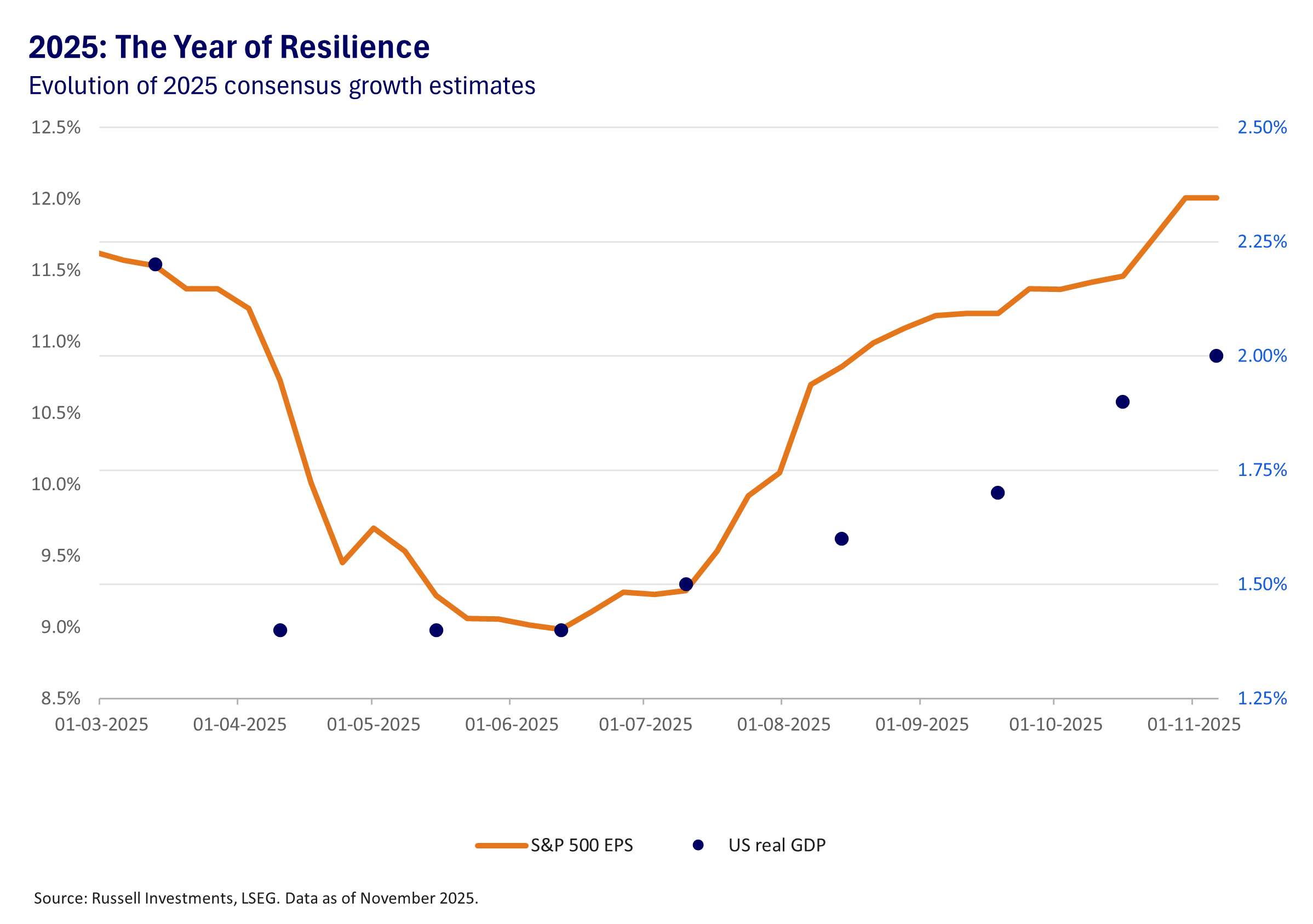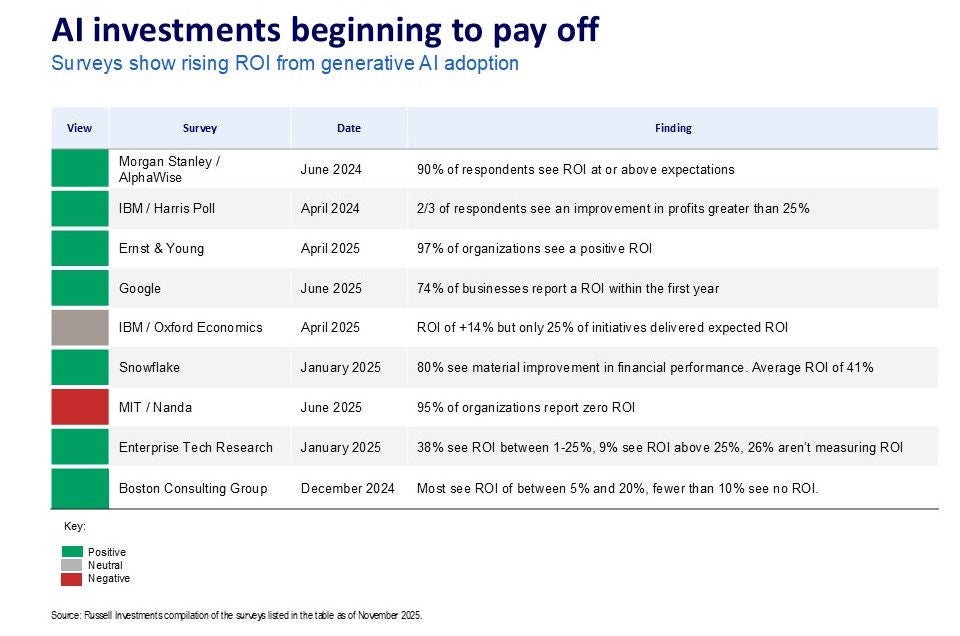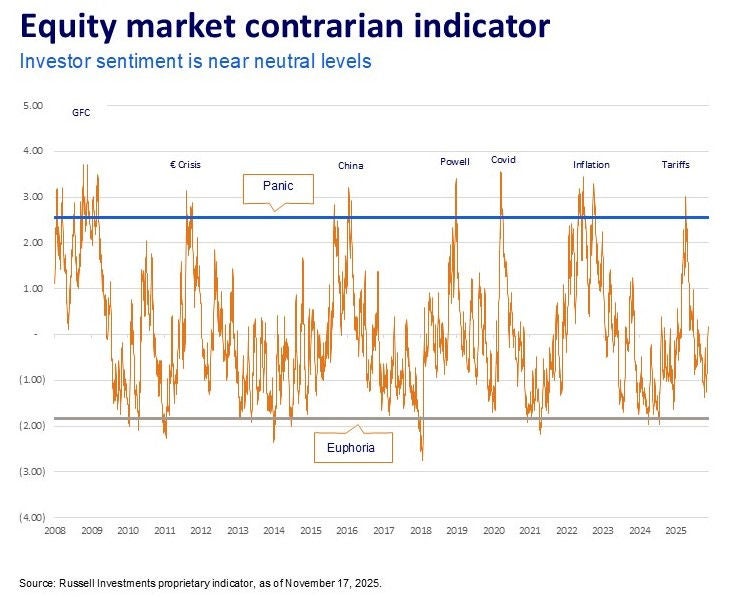2026 Global Market Outlook
The Great Inflection Point
Policy upheaval defined the first half of 2025. Investors faced a multitude of policy shifts this year. April’s Liberation Day ushered in the biggest increase in tariffs since the 1930s. We saw the sharpest immigration restrictions since the 1950s, the most ambitious deregulation agenda since the 1980s, and stimulus bills in the United States and Germany.
Yet through that turbulence, markets adapted. Resilience emerged as the defining theme for 2025, with most global equity markets dramatically rebounding from their April lows to close out the year near all-time highs. Fundamentals have since exceeded even our relatively upbeat expectations, with consensus estimates for economic and earnings growth recovering almost all their post-Liberation Day declines.

That resilience now gives way to a new phase—the great inflection point. The policy shocks of 2025 may have tested the system, but they also accelerated deeper shifts in technology, growth dynamics, and global capital flows. As the macro landscape stabilizes, markets are no longer reacting to policy disruption; they are repositioning for what comes next.
We see three inflection points that are likely to drive the investment landscape into 2026 and beyond. First, AI adoption is likely to accelerate further, reshaping energy demand, productivity, and profitability across sectors. Second, we see potential for the U.S. economy to regain momentum as the drags from tariffs and policy uncertainty fade and the tailwinds from loose financial conditions and fiscal stimulus build. Third, we expect a broadening opportunity set, with greater performance dispersion as capital rotates toward new areas of leadership in the next phase of global growth.
Rise of the Machines: The Productivity Revolution
Looking into 2025, we anticipate a soft landing for the U.S. economy. Our assumption is that the new administration will ease its more aggressive stances on tariffs and immigration. With these dynamics in mind, here are our key economic views for 2025:
U.S. Growth and Policy Trade-offs
The U.S. economy is expected to grow at a trend-like pace of 2.0% in 2025 in response to the lagged impact of tight Fed monetary policy. Core personal consumption expenditures (PCE) inflation is projected to move closer to the Fed’s 2% target, while the central bank eases rates gradually, with the fed funds rate likely to reach 3.25% by year-end—aligning with its neutral level.
The Trump administration’s policies present a delicate balancing act. Tax reforms and deregulation are likely to stimulate growth, particularly in domestic and cyclical sectors. Tariffs and immigration restrictions, however, could trigger a stagflationary shock that might have the Fed contemplating a rate hike as the economy weakens.
Our working assumption is that the new administration will not aggressively pursue policies that create inflation risk. One clear message from the election is that U.S. voters were unhappy with the inflation of the Biden years. Tariffs and immigration controls are likely to be implemented, but their extent will be constrained by the inflation outlook. On balance, we see the policy mix as supportive for business confidence, which is likely to drive a resurgence in capital markets and provide positive tailwinds for private assets.
Global Headwinds and Policy Divergences
Outside the U.S., growth will likely remain under pressure. Trade policy uncertainty and tariffs will weigh heavily on Europe. The European Central Bank (ECB) is likely to cut its deposit rate to 1.5% by year-end to offset the tariff impact and the continued stagnation of the German economy.
The UK faces sluggish productivity growth, labour constraints, and inflationary impacts from higher taxes under the new Labour government. The Bank of England’s (BoE) capacity to ease is constrained, with the base rate likely to decline only modestly to 3.75%–4.0%.
Japan remains an outlier, supported by a virtuous wage-price spiral that will anchor inflation expectations near 2%, allowing the Bank of Japan (BoJ) to further normalisze policy. Rates could rise to a 30-year high of 0.75% by year-end.
China faces headwinds from the property market collapse, deflation pressures, and U.S. tariffs. The policy response continues to be reactionary, rather than one where proactive steps are taken to solve structural problems such as high savings and low household consumption. There are downside risks to consensus expectations for 4.5% GDP (gross domestic product) growth in 2025.
Market Sentiment and Valuations
Three defining features of the market outlook for 2025 are the elevated level of the S&P 500 forward P/E (price-to-earnings) ratio at 22x, the potential for further U.S. dollar strength, and the direction of the U.S. 10-year Treasury yield.
Elevated equity valuations make the U.S. market vulnerable to negative surprises, and further dollar strength will challenge emerging markets. Sustained U.S. Treasury yields above 4.5% could challenge equities, diminishing the earnings yield advantage stocks have enjoyed over bonds since 2002.

This is good news for two reasons. First, it’s likely to sustain AI investment and adoption. Second, it suggests the benefits are starting to spread from AI builders to AI users. This could support a positive broadening out of fundamentals and performance.
While AI-related capital expenditures and the data center buildout are already contributing to growth in the United States and China, they also pose important risks to economies and markets. For instance, AI could disrupt labor markets if adoption proves to be much faster than prior general-purpose technologies. It could also upend long-standing business models. There is already evidence of this occurring, with some online knowledge platforms reporting a significant decline in web traffic revenue. Lastly, the scale of capital required to build AI could pressure funding markets. For now, this capex is overwhelmingly funded by internal cash flows, but by 2030 financing needs could be more than $1 trillion.
Rethinking Resilience
The global economy stands at an inflection point. While investors continue to face a complex mix of technological and policy crosscurrents, growth drivers are starting to shift within the United States and globally. In the U.S., trade agreements have stabilized tariff rates in recent months and lessened some of the policy uncertainty that plagued markets in the first half of 2025. This suggests we have passed through the peak hit from tariffs. Meanwhile, very loose financial conditions—particularly from the strong rally in equity markets—are likely to support economic growth, especially amongst higher-income consumers. As headwinds fade and tailwinds build, our analysis suggests the balance of risks are shifting from resilience to reacceleration. We see the potential for above-trend real GDP growth of 2.25% to 2.5% in 2026.

Source: Russell Investments
Asset Class Implications:
Equity: We are focused on U.S. small caps, where post-election dynamics, improving earnings, and attractive valuations may create compelling opportunities. We also see growth managers targeting high-growth cyclicals like software, while value managers identify M&A (mergers and acquisitions) potential in financials and healthcare. Core managers are balancing cyclical exposure and managing risks in rate-sensitive sectors.
In addition, we expect increased market volatility from U.S. foreign policy actions to create opportunities for active managers to find quality companies temporarily impacted by headline risks.
Fixed Income: We see a steepening yield curve offering opportunities in short-term bonds, as short-term rates are expected to decline faster than long-term yields. Credit markets may have limited upside due to tight spreads, particularly in U.S. high-yield and investment-grade bonds. This creates an opportunity to expand fixed income exposure into areas with more attractive risk/return trade-offs, such as emerging-market U.S. dollar bonds and private credit.
Currencies: The U.S. dollar is expected to face upward pressure from tariffs, the strength of the U.S. economy, and a less dovish Fed compared to other central banks. However, its valuation remains high, and emerging market currencies have already been under pressure. Given this, we are keeping currency bets in portfolios limited for 2025, while staying alert to any opportunities and risks that may arise throughout the year.
2. Private Markets: The New Growth Engine
Private markets continue to play an increasingly vital role in the evolving landscape of capital flows, as the shift away from public markets accelerates with fewer IPOs (initial public offerings) and later-stage listings. This transformation is particularly evident in AI opportunities, where venture capital investments now make up 27% of deals and 41% of capital raised.1 In our view investors can benefit from broadening portfolios into private markets. The upcoming policy environment may also be more favorable for private markets, with stabilizing interest rates, easing regulations, and rising M&A activity. However, the influx of capital into U.S. private markets has led to sourcing challenges, which makes international opportunities more attractive. In particular, Europe offers compelling middle-market consolidation opportunities in fragmented industries, Japan benefits from ongoing corporate reforms and asset divestitures, and the Persian Gulf states are emerging as dynamic investment hubs thanks to progressive regulations and large-scale development initiatives. Infrastructure also presents a key opportunity, as hybrid investment models that incorporate both private and public markets unlock substantial growth potential.
We believe a multi-manager approach is crucial in this landscape. By diversifying across specialized managers, particularly in real assets, investors can access a broader range of opportunities that blend public and private market investments. This strategy creates more resilient portfolios and allows investments in sectors such as data centers and warehousing, where combining private and public market exposures is especially productive for a total portfolio.
Building upon the resilience theme from 2025, we believe solid economic fundamentals should support strong earnings fundamentals and protect against a layoff cycle. While weak hiring trends are a key risk to this view, we estimate 85% of the recent decline in job growth comes from immigration restrictions and curtailed government employment. In other words, we think the slowdown is being driven mostly by policy choices and isn’t a symptom of cyclical weakness. If our outlook for the economy proves correct, the Federal Reserve—which recently cut interest rates to protect against emerging labor-market weakness—may slow down or halt its easing cycle into early 2026. 10-year Treasuries currently trade near our 4.1% fair value estimate1, supporting a strategic allocation to duration risk in portfolios.
Outside the U.S., the European economy is in a good place with inflation running near the 2% target, a healthy and balanced labor market, normal European Central Bank policy rates, and steady economic growth. A key watchpoint for the region will be the crystallization of infrastructure and defense commitments from Germany’s fiscal stimulus package, with some estimates suggesting it could double growth in the region’s largest economy next year.
Meanwhile, emerging markets show mixed economic performance, with China expected to deliver annual growth near the government’s target of 5% in the near-term. Corporate earnings have been a clear bright spot in the region, with a substantial upgrade cycle driven by Chinese technology names and a structural reform program in South Korea that is already paying dividends. The emerging markets remain a preferred overweight in our global equity strategies for 2026.
1 Fair value estimates are our opinions, subject to change, and are not a guarantee of market levels.
Market Implications:
- Private Equity: We are focused on private equity opportunities in European middle-market consolidation, along with continued growth in Japan and the Persian Gulf states. Managers with sector-specific expertise are outperforming generalists, and we believe that portfolios can benefit from this trend.
- AI and Tech: We believe private market ventures in AI, particularly those focused on scaling innovative technologies across industries, will continue to be key drivers of long-term growth. We are actively looking for investments in AI-driven companies that are poised to enhance productivity and reshape industries.
- Private Credit: We see private credit as a resilient asset class, particularly in the current higher-rate environment. With asset-based lending and European direct lending providing attractive relative value, we are broadening our fixed income exposures into these areas to capture higher yields and better diversification.
- Infrastructure: We are favourable to infrastructure as a long-term growth anchor and a hedge against inflation. The asset class has proven resilient during recent market volatility and benefits from long-term trends such as the energy transition, renewable energy, and digitalization. Increasing demand for sustainable and digital infrastructure continues to drive significant capital inflows. Additionally, hybrid models combining private and public market exposure are unlocking new growth potential.
- Venture Capital: We see significant opportunities in AI-driven venture capital, particularly in early-stage companies with the potential to reshape industries. As the VC market stabilizes, we are concentrating on firms with strong fundamentals, a track record of innovation, and a capacity to scale effectively.
3. The Broadening out of Market Leadership
While mega-cap AI stocks have driven market returns in recent years, leadership is shifting to companies using AI to create real-world efficiencies. The new U.S. administration’s focus on deregulation and tariff-based policies may provide an added boost to smaller, domestically oriented companies, which are less exposed to international trade disruptions than mega caps with significant foreign revenue, such as Apple.
We see this shift reducing market concentration and opening the door for alpha opportunities. Active managers will likely play a critical role in identifying under-covered firms that are adopting AI to drive productivity and gain competitive advantages. As AI adoption accelerates, driven by falling costs, we expect companies leveraging these innovations to benefit from enhanced productivity and improved competitiveness. Additionally, with interest rates stabilising and valuations improving, real assets such as real estate and infrastructure are becoming increasingly attractive, offering growth, income stability, and inflation protection amid policy uncertainties.
Market Implications:
- Equity: Active equity managers have been challenged by the recent severe market concentration. Our research indicates that even a flattening out of these trends—which could be driven by policy shifts, or changing sentiment around earnings growth and valuations for mega caps—can be quite supportive for active manager outperformance. We and our active managers are focused on sectors where AI adoption is accelerating, such as industrials, healthcare, and consumer goods. We believe companies leveraging AI for productivity improvements are well-positioned to gain a lasting competitive edge and generate strong returns. Skilled active managers can seek out these companies, especially those in less-covered segments of the market.
- Real Assets: We see attractive investment opportunities in real estate and infrastructure, particularly in areas benefiting from stabilising long-term interest rates and favourable relative valuations compared to other growth assets. AI applications in real estate, such as data centres and healthcare facilities, are emerging as key growth areas. Additionally, infrastructure investments are gaining momentum from energy utilities and pipeline exposures, especially with the U.S. administration's focus on expanding LNG (liquified natural gas) production.
The Great Rebalancing
We believe broadening growth and profitability, supported by AI-driven gains, signal a turning point in market leadership beyond the U.S. hyperscalers. We expect greater dispersion ahead, creating new opportunities for selective positioning.
While equities trade near all-time highs and valuation multiples are high relative to history, our proprietary indicator of market psychology for the S&P 500 does not show worrying signs of euphoria that would motivate a more cautious tactical posture in portfolios. Based on current sentiment levels, we believe equities may outperform bonds over the next 12 months. We believe retail and institutional investors should stay invested with risk levels up near strategic targets.

Improving global earnings fundamentals and the potential for the trade-weighted U.S. dollar to weaken supports the case for global diversification, with emerging markets being one potential area of opportunity for active management to shine.
U.S. Treasuries trade near our estimates of fair value across the curve, supporting a strategic allocation to duration in fixed income and multi-asset portfolios. At the same time, public market credit spreads are historically tight with specialist managers finding opportunities to rotate exposure into equities, securitized credit, and private market debt—which continues to trade at a substantial yield advantage to public markets.
In addition, long-term shifts toward increasing geopolitical risk, supply chain resilience, and record and rising government debt levels highlight the importance of extending portfolio resilience and access through allocations to real assets, private markets, and new alternative diversifiers.
Investor Implications
For 2026, we’re positioned for resilience and reacceleration over recession. We’re staying invested, leaning into security selection to add value in disperse markets, and leaning into an increasingly diverse set of return drivers to support portfolio outcomes.
Equities Outlook
By Will Pearce, Megan Roach, and Pierre Dongo-Soria
Broadening leadership across public and private markets
Equity markets are entering a new phase of broadening growth as fundamentals strengthen and leadership widens. Public and private assets alike are benefiting from renewed optimism tied to the next phase of the AI investment cycle and a more balanced global backdrop. We see greater dispersion creating opportunities for active managers to add value across both listed and private markets.
Key takeaways:
- Market leadership is broadening as AI adoption shifts from early “builders” to widespread “users.”
- We see improving breadth across Europe, Japan, and emerging markets.
- Active managers are finding opportunity in valuation gaps and heightened dispersion.
- Private equity and venture capital are capturing the next wave of AI-enabled opportunities.
Capital flow and the new AI phase
The defining force for equity markets continues to be the AI buildout, but its impact is changing. The early infrastructure cycle—led by hyperscalers and semiconductor firms—is now expanding into broader corporate adoption. Companies that apply AI to boost productivity and margins are emerging as the next beneficiaries.
This evolution is reshaping global equity performance. While U.S. mega-caps remain influential, the investment impulse from AI infrastructure and adoption is now reaching non-U.S. regions and mid-cap innovators. For equities, that means a shift from a narrow trade in platform leaders toward a wider set of opportunities grounded in earnings delivery and operational efficiency.
Managers see this broadening phase as an opportunity to differentiate through stock selection. With fundamentals improving but valuations uneven, disciplined active positioning remains key to capturing dispersion.
Global breadth and active opportunity
Valuations remain elevated overall, but participation is improving. Europe and Japan continue to benefit from policy reform and fiscal momentum, while Asia’s technology and industrial sectors are leading earnings upgrades. We see particular value where fundamentals are improving yet pricing remains reasonable—from emerging-market technology to European cyclicals and U.S. firms embedding AI to drive efficiency gains.
We believe this renewed dispersion favors active management. Portfolio managers are emphasizing diversified selection, measured tilts toward value and quality, and selective exposure to small and mid-caps. High-momentum names remain underweighted as teams focus on durable earnings and balanced regional exposure. Across our platform, managers highlight that the current cycle rewards precision—allocating capital where fundamentals are improving faster than valuations.
Growth and value managers alike are adapting their approaches to the AI evolution. Growth-oriented teams are focusing on firms demonstrating tangible productivity gains and scalable earnings leverage, while value managers are identifying opportunities in companies adopting AI more gradually, where fundamentals and pricing power are improving. This stylistic balance reflects a disciplined shift toward quality and sustainability within active portfolios.
Private markets in parallel
Private capital is advancing alongside public markets. The AI infrastructure wave is fueling new deal flow in data centers, automation, and energy transition technologies. Venture and growth equity investors are targeting innovation adjacent to public-market leaders, while private equity managers are finding improved exit conditions as leadership widens beyond U.S. mega-caps.
Should valuations reset, disciplined entry points could emerge for long-term private investors. Many managers view this as a constructive moment to align private exposures with listed-market themes, emphasizing the complementary role of private assets in capturing the next leg of innovation and growth.
Investor implications
We see equity markets transitioning toward renewal—characterized by improving growth, rising dispersion, and broader leadership across regions, styles, and asset types. For investors, this environment supports a balanced approach: diversified, quality-oriented equity exposure complemented by private and growth-stage strategies positioned to harness structural innovation.
From our vantage point, active management remains central to navigating dispersion and identifying where the next phase of value creation will emerge—across both public and private markets.
We believe managers who can integrate insights across public and private opportunities—and balance growth innovation with value discipline—are best positioned to capture the evolving AI-driven landscape.
Fixed Income Outlook
By Van Luu, Riti Samanta, and Keith Brakebill
Duration, debt, and dispersion
Lower policy rates and shifting fiscal dynamics are reshaping the global fixed income landscape. Public and private debt markets enter 2026 from different starting points, yet both face a year likely to be marked by dispersion, selectivity, and recalibration.
Key takeaways:
- U.S. Treasuries remain near fair value, offering strategic duration and portfolio ballast.
- Divergent global policy paths create opportunities for relative-value positioning.
- We believe tight public credit spreads favor active security selection and exposure to securitized credit.
- Private credit and asset-based finance continue to deliver structural yield and diversification.
A market in transition
Fixed income delivered strong results in the second half of 2025 as policy rates declined and credit spreads tightened. Inflation pressures have eased, and investor focus has turned to the fiscal outlook across developed markets.
Public and private fixed income markets are now diverging. In public markets, U.S. Treasuries have regained footing following the Federal Reserve’s rate cuts. In private markets, the higher-for-longer yield environment continues to underpin attractive opportunities for long-horizon investors. Together, these segments offer complementary roles: duration and diversification from public debt, and structural yield from private credit.
We believe all-in yields remain compelling. AAA-rated investment-grade bonds offer about 50 basis points over 10-year Treasuries, while higher-quality high yield bonds deliver yields over 6%.2 Fundamentals remain sound with manageable leverage and strong interest coverage, while issuance has been robust and oversubscribed. Tight spreads have led many managers to hold elevated Treasury allocations, though short-lived selloffs have created selective relative-value opportunities. Early signs of stress in subprime borrowers remain isolated and contained.
A weaker U.S. dollar has also supported local-currency emerging-market bonds, expanding opportunity sets that had been narrow through much of 2024. Policy and data uncertainty, including delayed U.S. economic reports, remain a watchpoint as investors navigate the next phase of easing.
Policy easing meets fiscal strain
The Fed’s shift toward easing marks a clear inflection point for global rates. Short- and intermediate-term maturities have benefited most, while fiscal pressures in other developed markets have introduced fresh dispersion. At the 10-year maturity point, UK gilts and U.S. Treasuries trade roughly 50 basis points apart—illustrating how divergent inflation and growth narratives can shape opportunities.
We expect this combination of monetary accommodation and fiscal strain to keep yield curves biased toward mild steepening as long-term issuance rises. In the U.S., Treasuries remain close to fair value, supporting a neutral duration stance. UK yields appear attractive following fiscal-driven volatility, suggesting scope for recovery as budget clarity improves. Across bond markets, investors continue to weigh policy relief against fiscal risk—a tension likely to define 2026.
Credit markets: Structure over spread
Public credit spreads remain near historic tights, leaving limited room for compression. We have trimmed exposure to investment-grade corporates, where valuations already price in optimism, while favoring securitized credit—particularly non-agency mortgage-backed securities—for their exposure to real assets with lower rate sensitivity. Collateralized loan obligations (CLOs), roughly a third of the securitized universe, offer low-duration, floating-rate structures that suit an uncertain rate backdrop.
We believe private credit remains a bright spot. Yield advantages and structural protections continue to attract capital, particularly in asset-based finance secured by tangible collateral. The next phase of AI-driven corporate investment is also expanding issuance across both public and private credit markets, creating new opportunities for managers able to navigate complexity and structure.
Investor implications
We see value on both sides of the fixed income spectrum. Public markets provide fair-valued duration and liquidity as policy easing unfolds, while private markets deliver yield, diversification, and access to real-economy assets.
Fiscal expansion and elevated issuance may keep long-term yields under gentle pressure, underscoring the importance of selectivity and active management. We see the coming phase as less about chasing yield and more about balancing liquidity, credit quality, and curve exposure—in order to position portfolios for resilience across the fixed income landscape.
2 Source: Federal Reserve Bank of St. Louis
Real Assets Outlook
By BeiChen Lin and Tim Ryan
Infrastructure, real estate, and the AI buildout
As the global economy shifts from resilience to reacceleration, both public and private real assets are emerging as essential diversifiers. Listed infrastructure and real estate offer liquidity and market access, while private real assets provide durable cash flows, structural yield, and direct exposure to the AI and energy transition buildouts. Together, we believe these exposures can anchor multi-asset portfolios through 2026 as secular demand for power, resilient logistics, and defense-adjacent infrastructure grows.
Key takeaways:
- Valuations in listed real assets look attractive versus equities, but less so versus government bonds.
- We see AI, energy transition, and national security as persistent demand drivers for infrastructure.
- We believe private real assets offer yield and resilience while public markets provide liquidity and tactical access.
- Security selection and manager skill remain the primary return drivers across public and private strategies.
Portfolio diversification in a new macro phase
With recession odds lower and policy uncertainty easing, real assets are poised to reclaim a central role in diversification. Listed infrastructure and REITs continue to trade at discounts to broader equities, highlighting relative value opportunities for public allocations. At the same time, private strategies can smooth volatility and capture long-dated cash flow growth that listed markets may not fully reflect. We favor a balanced approach that uses public markets for tactical tilts and private markets for structural exposure.
Infrastructure: Power, transition, and defense
Three themes continue to define infrastructure’s appeal: the rise of AI, the energy transition, and increasing national security investment.
First, AI’s expanding footprint is lifting power consumption and stressing grids already near capacity. That creates a multi-year investment cadence for generation, storage, and distribution projects—opportunities accessible through both listed utilities and private energy infrastructure. Second, the energy transition continues to advance unevenly but meaningfully across regions. Europe’s renewables push and grid upgrades is a great example of this. Third, rising national security budgets are reallocating capital to defense-adjacent infrastructure, from military accommodation to logistics and secure energy facilities.
Energy security and defense themes are attracting growing private capital. U.S. markets currently offer more transactional scale and faster private capital deployment than some parts of Europe—factors that shape where private managers are active.
Real estate and private markets: The power of selectivity
Real estate benefits from the easing rate cycle, but valuation appeal varies across subsectors. Data centers remain a high-conviction area because AI drives sustained demand for hyperscale capacity. Aging demographics support senior housing and healthcare real estate. In private markets, managers are targeting assets with essential, contracted cash flows—utilities, telecom towers, logistics and specialized industrials—while steering clear of more cyclically exposed properties.
Defense-related and energy security assets are also moving from niche to mainstream for institutional allocators, with governance and regulatory clarity shaping European investor appetite. This reinforces our view that manager selection and thematic alignment will be critical in driving outcomes.
Investor implications
We see both public and private real assets as core building blocks for 2026 portfolio construction. Public real assets provide liquidity, price discovery, and valuation discipline. Private real assets offer income durability, lower public-market correlation, and direct exposure to structural spending on AI infrastructure, energy security, and defense-adjacent projects.
We believe investors should consider balancing listed and unlisted allocations, emphasizing specialist managers with sector expertise, and prioritizing assets with contracted or essential cash flows. Where private markets show faster deployment—particularly in the U.S. for defense and energy security—investors may find attractive entry points, but they should also account for regional regulatory and execution differences.
Asset Class Preferences
This snapshot highlights our latest asset class views. Click on each box to learn more about the opportunities and risks shaping our perspective.
Regional Snapshots

United States
With trade policy coming off the boil and resilience in corporate earnings, consumer spending and labor markets, we expect the U.S. economy to grind through this volatile period with slower, but still-positive growth in the year ahead. Fed rate cuts have been delayed but not derailed by tariffs—we expect one or two moves later this year. Treasuries are cheap but we believe the risks to the fiscal outlook demand more yield before stepping in—we’d look to add duration at 4.9% on the 10-year bond. Credit spreads are unusually tight and unattractive for the degree of policy-driven volatility that lies ahead.

Canada
Canada had two back-to-back months of significantly stronger-than-consensus job creation in September and October, a sign that cyclical risks might have come down from the peak. Nevertheless, with the unemployment rate still around 7%, we continue to believe the nation may be more prone to recession risks than the U.S. over the next 12 months.
We remain neutral on Canadian equities, as cyclical headwinds are offset by better relative valuations compared to U.S. equities. Canadian government bonds are close to fair value, though they can still serve as an important strategic diversifier. Although overnight rates being at the lower end of the BoC’s neutral rate estimate creates a high hurdle for further rate cuts, the lingering macroeconomic uncertainty and remaining fragility in the labor markets imply there might still be more room for rate cuts into 2026.
In the near-term, we expect the Canadian dollar might remain under pressure from the soft economy, but will likely strengthen over the medium term against the U.S. dollar.

Eurozone
Divergent fiscal policies are likely to drive divergent euro area growth outcomes in 2026. A ramp-up in German defense and infrastructure spending is likely to accelerate growth in the bloc’s largest economy, with positive spillovers to key trading partners like Austra, Belgium, and the Netherlands. Meanwhile, fiscal consolidation in France, Italy, and Spain is likely to keep the region in low-gear growth with GDP running a whisker above 1% in 2026. We think ECB policy is in a “good place” with inflation near target and labor markets steady. German bunds trade near our estimate of fair value. Value is a preferred style exposure in eurozone equities.

United Kingdom
The UK economy continues to stagnate with activity and labor markets weakening in recent months. Growth drivers are likely to shift from fiscal to monetary policy during the year. The budget is expected to raise taxes with a backloaded drag on growth in 2026. We expect the Bank of England to cut policy rates to 3% to stabilize the economy as upside risks to inflation fade. UK gilts are a preferred exposure across G7 sovereigns for 2026. We believe UK equities are likely to outperform the UK economy as the index’s weighting to large multinationals provides exposure to a healthier global business cycle.

China
The reduction in trade tensions is a positive. However, China’s underlying economy remains soft. The property market is showing early signs of improvement, which could lead to a pick-up in consumer spending. Chinese stocks are cheap relative to other emerging markets, and we are encouraged by the continued rise in return on equity. China's government bond yields are still hovering near record lows, while we expect the yuan to trade in a tight range.

Japan
Inflation expectations have moved back toward the Bank of Japan’s (BoJ) target, with the bond market now pricing five-year inflation expectations slightly above 2%. The domestic economy has been improving, although the outlook remains contingent on the direction of trade tensions. We expect the BoJ to keep rates on hold over the next 12 months given the backdrop of trade policy uncertainty and global easing. Japan’s corporate performance has continued to improve amid a backdrop of fair valuations, while government bonds still appear expensive despite the recent selloff.

Australia and New Zealand
The Australian economy has started to see improvement in the last three months, with consumer spending responding to Reserve Bank of Australia (RBA) rate cuts earlier this year. The labor market has softened over the last six months, with some spare capacity opening up, but hiring intentions remain robust. We expect the RBA will reduce rates once in the first half of 2026. Australian government bonds look attractive relative to global bonds, while we think Australian equities have limited upside.
The New Zealand economy is likely bottoming out following the substantial rate-cutting cycle from the Reserve Bank of New Zealand (RBNZ). The housing market has been weighing down the economy, but lower rates should start to support a housing recovery. The New Zealand dollar looks undervalued, while New Zealand equities remain expensive relative to global equities.
